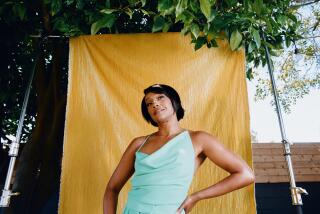Abstract View of Calligraphy : Art: Kazuaki Tanahashi’s works encourage quiet contemplation, even though some are four feet high.
There is something all too familiar about Kazuaki Tanahashi’s black-and-white paintings. Tanahashi, whose work is on view at the David Zapf Gallery, has taken the ancient tradition of calligraphy and modernized it in the celebrated American painting vernacular of abstract Expressionism.
The melding of Oriental philosophy and abstract art is not new; obvious examples of well-known American artists who have done so include Mark Tobey, Ad Reinhardt and Robert Motherwell, to name a few. Tanahashi’s exhibit evokes a feeling of deja vu , even though he is a Berkeley-based Japanese-born artist with formal training in calligraphy.
Nevertheless, this show should not be dismissed as stale.
The beautiful, poetic nature of Tanahashi’s paintings encourages the quiet contemplation one occasionally needs in our frantic and often aggressive society. Using an oversized brush, Tanahashi paints his large calligraphic images in exaggerated gestures that are often as much as 4 feet high.
Because the innovation of this personalized gesture is bounced off tradition, the artist, by combining the dual philosophies of East and West, communicates in visual languages. Interpretations of traditional calligraphy, probably best appreciated by those well versed in this art form, include the Japanese ideograms “Returning,” “Playing,” “Flying,” and “Motion.” The rest of the paintings use abstract gesture to communicate the same kind of Eastern thinking.
The title of the triptych, “Jo Ha Kyu,” for example, translates to “Introduction, Breaking and The Swift Conclusion,” a triad that forms the basic structural principle of Japanese music and theater. The rise and fall of the artist’s brush strokes literally illustrate this three-part pattern in this large work.
A suite of paintings titled “East, West, North, South” appears more American because, according to the artist, the West’s basic movement is geometric. Based on a riddle by the 14th-Century master Zen poet Ikkyu--that truth is found in the four directions--this time Tanahashi’s interpretation uses precise angular gestures and lines. The high contrast between the black and white areas of canvas portrays the divisions in the world: racial, financial, political, religious, and so on. And the fact that Tanahashi has created only three paintings to illustrate the four directions may be an allegory for the idea that truth is an enigma.
The artist’s experiments with the diverse nature of the brush stroke led to a few disappointments, however. When he works boldly and swiftly in a work like “Now 5”--a conspicuous imprint that resembles a photo of the sun--the work can be very powerful. But the wispy lines in “Billows” and “Where Are We All Going? 29” meander more than communicate.
Kazuaki Tanahashi’s “The Swift Passage of the Brush” continues at the David Zapf Gallery through Feb. 1.
LA JOLLA--”Video Works by UCSD Faculty and Graduate Alumni,” on view at UC San Diego’s Mandeville Gallery, contains a dizzying array of videos by 25 alumni and four faculty members. It adds up to about 10 hours of viewing time, made palatable by comfortable chairs and the ability to switch videos simply by moving from one room to another.
Because this is an exhibit with no theme, the works are as diverse as the artists whose works are included. Political and social issues are addressed, as well as philosophy, ideology, autobiography, the mass media and the video medium. Still, one trait did surface. This experimental art form that initially questioned, and then eventually helped to undermine the status of painting and sculpture, is here primarily concerned with humanity.
As there is really no better format than video for subverting the seductiveness of television and mainstream film, several videos do just that.
Jan Peacock’s “Whitewash” uses the television news format to examine both sexual and cultural stereotypes. Through a series of incidents, the artist moves through familiar news and advertising scenarios to zero in on the subliminal messages of television.
More forceful and political in its message is “Muqaddimah Li-Nihayat Jidel (Intifada) Speaking for Oneself. . . . Speaking for Others” by Jayce Salloum and Palestinian filmmaker Elia Suleiman. By fusing documentary footage of Palestinians with clips from movies, news reports, sitcoms, game shows and cartoons, Salloum and Suleiman destroy, and then reconstruct the West’s perceptions of the Middle East. Both the abundance and the diversity of these clips drive in the message that we “speak” for a culture we do not understand.
Of course, in recent years the mass media have been saturated by events in the Middle East. Gene Gort’s “figure/GROUND” is an allegory of a hostage-captor situation. While the hostage speaks of his feelings of identification with his captor, we watch a hawk in flight as it becomes one with nature.
Less successful in its premise is “The Desert Bush” by Sherry Millner and Ernest Larsen. It so obviously satirizes President Bush and the Gulf War that it undermines its intention to critique the United States’ imperialistic attitudes and policies.
The scope of this exhibit allows for only a superficial treatment here. This show does, however, confirm that video art is a strong aspect of the UCSD art department, and as an introduction to and overview of the video medium, this is as good a place as any to start.
“Video Work by UCSD Faculty and Graduate Alumni” continues at the Mandeville Gallery through Feb. 9.
* Editor’s note: For the next three months, Leah Ollman will be on leave from the At the Galleries column.
More to Read
The biggest entertainment stories
Get our big stories about Hollywood, film, television, music, arts, culture and more right in your inbox as soon as they publish.
You may occasionally receive promotional content from the Los Angeles Times.






